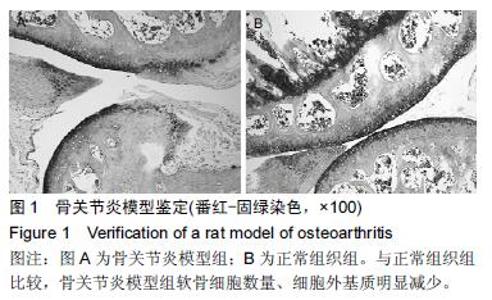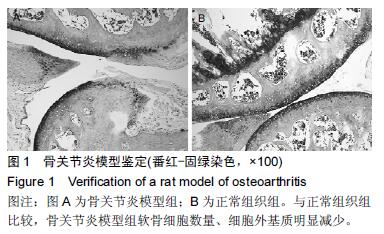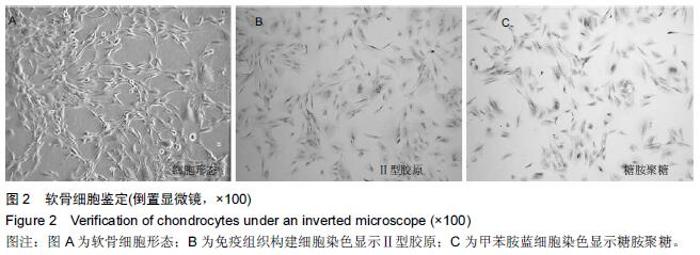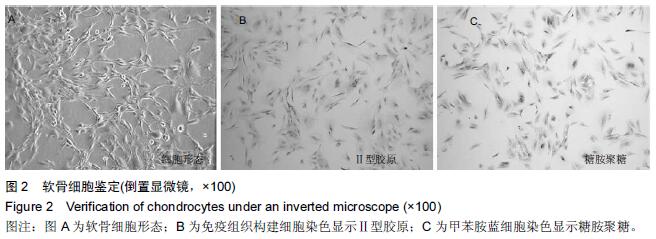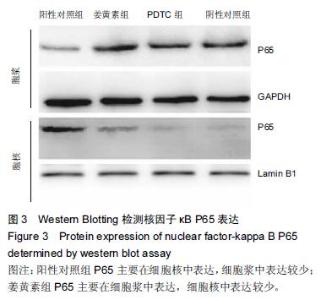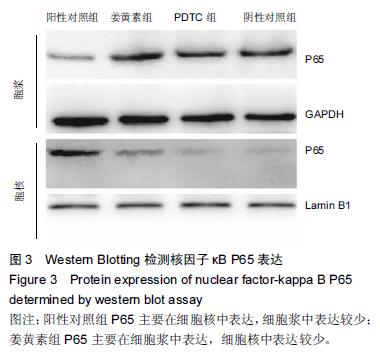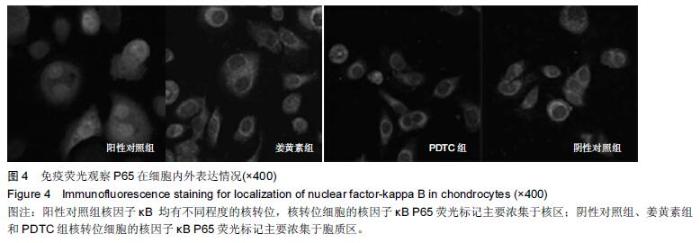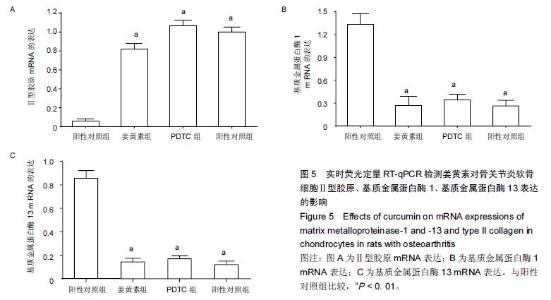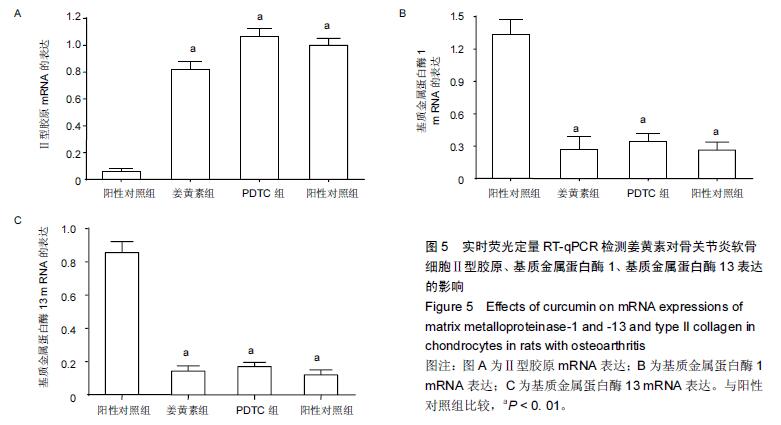Chinese Journal of Tissue Engineering Research ›› 2016, Vol. 20 ›› Issue (15): 2163-2170.doi: 10.3969/j.issn.2095-4344.2016.15.005
Previous Articles Next Articles
Curcumin inhibits nuclear translocation of nuclear factor-kappa B P65 in a rat model of traumatic osteoarthritis
Wang Jian, Ma Jie, Gu Jian-hua, Wang Fu-yong, Shang Xiu-shuai, Wang Zhao-fei, Wang Xiang, Tao Hai-rong
- Department of Orthopedics, Shanghai Ninth People’s Hospital, Shanghai Jiao Tong University School of Medicine, Shanghai 201900, China
-
Received:2016-02-04Online:2016-04-08Published:2016-04-08 -
Contact:Tao Hai-rong, M.D., Master’s supervisor, Associate chief physician, Department of Orthopedics, Shanghai Ninth People's Hospital, Shanghai Jiao Tong University School of Medicine, Shanghai 201900, China; Wang Xiang, M.D., Associate chief physician, Department of Orthopedics, Shanghai Ninth People's Hospital, Shanghai Jiao Tong University School of Medicine, Shanghai 201900, China -
About author:Wang Jian, Studying for master’s degree, Department of Orthopedics, Shanghai Ninth People's Hospital, Shanghai Jiao Tong University School of Medicine, Shanghai 201900, China -
Supported by:the Science and Technology of Development Program of Baoshan District, Shanghai, China, No, 13-E-5; the Medical-Engineering Cross Foundation of Shanghai Jiao Tong University, China, No. YG2014MS23
Cite this article
Wang Jian, Ma Jie, Gu Jian-hua, Wang Fu-yong, Shang Xiu-shuai, Wang Zhao-fei, Wang Xiang, Tao Hai-rong. Curcumin inhibits nuclear translocation of nuclear factor-kappa B P65 in a rat model of traumatic osteoarthritis[J]. Chinese Journal of Tissue Engineering Research, 2016, 20(15): 2163-2170.
share this article
| [1] Shi D,Dai J,Xu Z,et al.Update on basic and clinical aspects of osteoarthritis. Ann Transl Med. 2015;3(10):142. [2] Abeles AM, Pillinger MH.The role of the synovial fibroblast in rheumatoid arthritis: cartilage destruction and the regulation of matrix metalloproteinases. Bull NYU Hosp Jt Dis. 2006;64(1-2):20-24. [3] Tchetverikov I,Lohmander LS,Verzijl N,et al. MMP protein and activity levels in synovial fluid from patients with joint injury, inflammatory arthritis, and osteoarthritis. Ann Rheum Dis. 2005;64(5):694-698. [4] Aigner T,Soder S,Gebhard PM,et al.Mechanisms of disease: role of chondrocytes in the pathogenesis of osteoarthritis--structure, chaos and senescence. Nat Clin Pract Rheumatol. 2007;3(7):391-399. [5] Pardo A,Selman M.MMP-1: the elder of the family. Int J Biochem Cell Biol.2005; 37(2):283-288. [6] Tardif G,Reboul P, Pelletier JP, et al.Ten years in the life of an enzyme: the story of the human MMP-13 (collagenase-3).Mod Rheumatol. 2004;14(3):197-204. [7] Bharti AC, Aggarwal BB.Nuclear factor-kappa B and cancer: its role in prevention and therapy. Biochemical pharmacology.2002;64(5-6):883-888. [8] Mukhopadhyay A, Bueso-Ramos C, Chatterjee D,et al. Curcumin downregulates cell survival mechanisms in human prostate cancer cell lines.Oncogene.2001; 20(52):7597-7609. [9] Bharti AC,Donato N,Singh S,et al.Curcumin (diferuloylmethane) down-regulates the constitutive activation of nuclear factor-kappa B and IkappaBalpha kinase in human multiple myeloma cells, leading to suppression of proliferation and induction of apoptosis. Blood.2003;101(3):1053-1062. [10] Wan XH,Li YW,Luo XP. Curcumin attenuated the lipid peroxidation and apoptotic liver injury in copper-overloaded rats. Zhonghua Er Ke Za Zhi. 2007;45(8):604-608. [11] Shen SQ,Zhang Y,Xiang JJ,et al.Protective effect of curcumin against liver warm ischemia/reperfusion injury in rat model is associated with regulation of heat shock protein and antioxidant enzymes. World J Gastroenterol. 2007;13(13):1953-1961. [12] Chen Q,Wang Y,Xu K,et al.Curcumin induces apoptosis in human lung adenocarcinoma A549 cells through a reactive oxygen species-dependent mitochondrial signaling pathway. Oncology reports.2010;23(2):397-403. [13] Zhang XH, Xu XX, Xu T.Ginsenoside Ro suppresses interleukin-1beta-induced apoptosis and inflammation in rat chondrocytes by inhibiting NF-kappaB. Chin J Nat Med.2015;13(4):283-289. [14] Lee WT,Lee TH,Cheng CH,et al.Antroquinonol from Antrodia Camphorata suppresses breast tumor migration/invasion through inhibiting ERK-AP-1- and AKT-NF-kappaB-dependent MMP-9 and epithelial-mesenchymal transition expressions. Food Chem Toxicol. 2015;78:33-7841. [15] Wang JJ, Huan SK, Hsieh KH, et al. Inhibitory effect of midazolam on MMP-9, MMP-1 and MMP-13 expression in PMA-stimulated human chondrocytes via recovery of NF-kappaB signaling. Arch Med Sci. 2013;9(2):332-339. [16] Liacini A,Sylvester J,Li WQ,et al.Induction of matrix metalloproteinase-13 gene expression by TNF-alpha is mediated by MAP kinases, AP-1, and NF-kappaB transcription factors in articular chondrocytes.Exp Cell Res. 2003;288(1):208-217. [17] Chen C,Ma C,Zhang Y,et al.Pioglitazone inhibits advanced glycation end product-induced TNF-alpha and MMP-13 expression via the antagonism of NF-kappaB activation in chondrocytes. Pharmacology. 2014;94(5-6):265-272. [18] Cheng CC, Chen YH, Chang WL,et al.Phytoestrogen bavachin mediates anti-inflammation targeting Ikappa B kinase-I kappaB alpha-NF-kappaB signaling pathway in chondrocytes in vitro. Eur J Pharmacol. 2010;636(1-3):181-188. [19] Caterson B,Flannery CR,Hughes CE,et al. Mechanisms involved in cartilage proteoglycan catabolism. Matrix biology: Matrix Biol. 2000;19(4):333-344. [20] Yoshihara Y,Nakamura H,Obata K,et al.Matrix metalloproteinases and tissue inhibitors of metalloproteinases in synovial fluids from patients with rheumatoid arthritis or osteoarthritis. Ann Rheum Dis. 2000;59(6):455-461. [21] Westermarck J,Kahari VM.Regulation of matrix metalloproteinase expression in tumor invasion. FASEB J.1999;13(8):781-792. [22] Mort JS, Billington CJ.Articular cartilage and changes in arthritis: matrix degradation. Arthritis Res.2001;3(6): 337-341. [23] Goldring SR,Goldring MB.The role of cytokines in cartilage matrix degeneration in osteoarthritis. Clin Orthop Relat Res. 2004;(427 Suppl):S27-36. [24] Shakibaei M,John T,Schulze-Tanzil G,et al.Suppression of NF-kappaB activation by curcumin leads to inhibition of expression of cyclo-oxygenase-2 and matrix metalloproteinase-9 in human articular chondrocytes: Implications for the treatment of osteoarthritis.Biochem Pharmacol. 2007;73(9):1434-1445. |
| [1] | Huang Dengcheng, Wang Zhike, Cao Xuewei. Comparison of the short-term efficacy of extracorporeal shock wave therapy for middle-aged and elderly knee osteoarthritis: a meta-analysis [J]. Chinese Journal of Tissue Engineering Research, 2021, 25(9): 1471-1476. |
| [2] | Zhang Tongtong, Wang Zhonghua, Wen Jie, Song Yuxin, Liu Lin. Application of three-dimensional printing model in surgical resection and reconstruction of cervical tumor [J]. Chinese Journal of Tissue Engineering Research, 2021, 25(9): 1335-1339. |
| [3] | Peng Zhihao, Feng Zongquan, Zou Yonggen, Niu Guoqing, Wu Feng. Relationship of lower limb force line and the progression of lateral compartment arthritis after unicompartmental knee arthroplasty with mobile bearing [J]. Chinese Journal of Tissue Engineering Research, 2021, 25(9): 1368-1374. |
| [4] | Liu Xiangxiang, Huang Yunmei, Chen Wenlie, Lin Ruhui, Lu Xiaodong, Li Zuanfang, Xu Yaye, Huang Meiya, Li Xihai. Ultrastructural changes of the white zone cells of the meniscus in a rat model of early osteoarthritis [J]. Chinese Journal of Tissue Engineering Research, 2021, 25(8): 1237-1242. |
| [5] | Zeng Yanhua, Hao Yanlei. In vitro culture and purification of Schwann cells: a systematic review [J]. Chinese Journal of Tissue Engineering Research, 2021, 25(7): 1135-1141. |
| [6] | Cao Xuhan, Bai Zixing, Sun Chengyi, Yang Yanjun, Sun Weidong. Mechanism of “Ruxiang-Moyao” herbal pair in the treatment of knee osteoarthritis based on network pharmacology [J]. Chinese Journal of Tissue Engineering Research, 2021, 25(5): 746-753. |
| [7] | Li Yonghua, Feng Qiang, Tan Renting, Huang Shifu, Qiu Jinlong, Yin Heng. Molecular mechanism of Eucommia ulmoides active ingredients treating synovitis of knee osteoarthritis: an analysis based on network pharmacology [J]. Chinese Journal of Tissue Engineering Research, 2021, 25(5): 765-771. |
| [8] | Song Shan, Hu Fangyuan, Qiao Jun, Wang Jia, Zhang Shengxiao, Li Xiaofeng. An insight into biomarkers of osteoarthritis synovium based on bioinformatics [J]. Chinese Journal of Tissue Engineering Research, 2021, 25(5): 785-790. |
| [9] | Deng Zhenhan, Huang Yong, Xiao Lulu, Chen Yulin, Zhu Weimin, Lu Wei, Wang Daping. Role and application of bone morphogenetic proteins in articular cartilage regeneration [J]. Chinese Journal of Tissue Engineering Research, 2021, 25(5): 798-806. |
| [10] | Xu Dongzi, Zhang Ting, Ouyang Zhaolian. The global competitive situation of cardiac tissue engineering based on patent analysis [J]. Chinese Journal of Tissue Engineering Research, 2021, 25(5): 807-812. |
| [11] | Liu Xin, Yan Feihua, Hong Kunhao. Delaying cartilage degeneration by regulating the expression of aquaporins in rats with knee osteoarthritis [J]. Chinese Journal of Tissue Engineering Research, 2021, 25(5): 668-673. |
| [12] | Ma Zetao, Zeng Hui, Wang Deli, Weng Jian, Feng Song. MicroRNA-138-5p regulates chondrocyte proliferation and autophagy [J]. Chinese Journal of Tissue Engineering Research, 2021, 25(5): 674-678. |
| [13] | Wu Zijian, Hu Zhaoduan, Xie Youqiong, Wang Feng, Li Jia, Li Bocun, Cai Guowei, Peng Rui. Three-dimensional printing technology and bone tissue engineering research: literature metrology and visual analysis of research hotspots [J]. Chinese Journal of Tissue Engineering Research, 2021, 25(4): 564-569. |
| [14] | Chang Wenliao, Zhao Jie, Sun Xiaoliang, Wang Kun, Wu Guofeng, Zhou Jian, Li Shuxiang, Sun Han. Material selection, theoretical design and biomimetic function of artificial periosteum [J]. Chinese Journal of Tissue Engineering Research, 2021, 25(4): 600-606. |
| [15] | Liu Fei, Cui Yutao, Liu He. Advantages and problems of local antibiotic delivery system in the treatment of osteomyelitis [J]. Chinese Journal of Tissue Engineering Research, 2021, 25(4): 614-620. |
| Viewed | ||||||
|
Full text |
|
|||||
|
Abstract |
|
|||||
